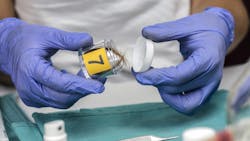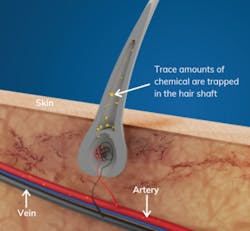The Federal Motor Carrier Safety Administration mandates random drug testing for 50% of a fleet’s drivers, but the agency only accepts urinalysis results. Urinalysis can only detect prohibited drug use, from marijuana to cocaine to opiates, in about a four-day window, though, and doesn’t provide any indication as to what that driver was up to a week or even a month earlier.
“Somebody could stop using for three or four days, come to orientation and pass a urine drug screen,” said Wilson Risinger, vice president of safety at KLLM Transport Services, on a recent webinar hosted by Psychmedics, the corporate drug testing company that developed hair testing in 1987.
With urine tests, Risinger found drug abusers were finding ways to evade detection, which is nearly impossible to do via hair testing.
“When somebody takes drugs and ingest them in their system, those drugs are metabolized into a person's bloodstream,” explained Charles Doucot, executive vice president at Psychmedics. These metabolites find their way into the hair, where they become trapped. Doucot called hair the body’s “tape recorder” because it logs “how much drugs you’ve taken and when you’ve taken it.” Detection in hair can extend up to 90 days.
Doucot said Psychmedics’ hair tests yield 10 times the amount of positives versus urinalysis. The Psychmedics test initially costs more than a urinalysis, but the cost per positive is 2.5 times less expensive than a urine test and 40% less than other tests, according to Doucot.
“That gives us the best ROI of any testing method or lab when you look at it from a cost-per-positive perspective,” Doucot said. “The hair test is virtually impossible to evade and cheat.”
Maverick Transportation has implemented hair testing since 2012 and can attest to the efficacy. In 10,000 drug tests, they have received 324 positives from hair testing versus 18 with urinalysis, reported Dean Newell, vice president of safety and former Truckload Carriers Association Safety Professional of the Year.
As of June, 2020 has yielded zero positives via 415 random urinalysis tests, intimating that the existence of hair tests deters would-be drug users from even attempting to circumvent the testing.
“Clearly the deterrent factor works,” Newell said. “You stop them upfront, and you don't have the issues later on down the road.”
And allowing cheaters to win becomes a major safety problem for fleets because they are authorizing a potentially dangerous individual the command of a giant truck and sending them onto the highway. If that driver gets into an accident while under the influence of alcohol or a controlled substance, the plaintiff wins 100% of the time in truck crash civil suits, said Allen Johnson, vice president at Psychmedics.
Due to the prevalence of nuclear verdicts, such a decision could wipe out a smaller fleet. Maverick has registered zero positives on post-accident drug test since 2012.
That fleet-killing verdict due to a slippery and sloppy drugged driver is of course the worst-case scenario, but not the only one where a fleet can lose big time due to drug abusers slipping through the cracks in the urinalysis testing program.
KLLM provides sign-on bonuses, so before they became a client of Psychmedics in March 2019, an applicant could show up for orientation, get paid for the week, and even get some or all of a bonus before testing finally outed them as drug users. Since testing began, KLLM weeded out 900 applicants. Hiring a truck driver in the U.S. can reach $8,200 per driver.
Risinger agreed that hair testing in an effective deterrent. After testing began, KLLM received a 1% positive urinalysis. Before that, it was 2.5%, or 57% lower.
Initially, Risinger reached out to other fleets doing hair testing and was impressed with their results.
“Once we saw that data, it became a pretty sobering realization for us that we were missing a lot of drug use only doing urinalysis,” Risinger said.
One of the nation’s largest fleets, U.S. Xpress, also shared data from its hair-testing program, which began in 2018.
Through July 2020, the rate for positive urinalysis was 0.9 and 8.5 for hair tests, revealed Greg McQuagge, vice president of safety for U.S. Xpress.
“Once we went down that path, we immediately saw the benefit in the positive rate,” McQuagge said. ”It's one of the best things we've ever done.”
U.S. Xpress started with its student population, which provides 50% of its hires. They received a higher rate from this population, McQuagge said, because they never held a commercial driver’s license and didn’t appreciate the impact drug use would have on safety.
When instituting the hair program, McQuagge advised that human resources, operations, and even sales understand the change. From a sales perspective, he said hair testing would show customers a fleet’s dedication to safety.
“We have seen great improvement year over year on accidents and also lost-time incidents,” McQuagge said.
McQuagge also warned that right after testing begins, expect to see a drastic decline in recruits making it through orientation. U.S. Xpress was hiring about 100 drivers a week, and that “dropped like a rock” to 30 to 40, he said. After the 60-day mark, that number returned to normal.
The key was educating recruiters on the process and reason why.
Some drivers, however, who value a paycheck over other people's lives, will continue to get high and find fleets to accept them.
“Drivers will self-select,” McQuagge said. “So as soon as you tell them that you're doing a hair test, they're gonna’ hang up the phone, and they're going to go to another company that is not performing the hair test.”
That question haunted Risinger prior to implementing the hair tests.
“We had to ask ourselves the question that when they failed a hair test at one company, where did they go to orientation?” Risinger said. “And the answer was probably us.”
Now KLLM is a fleet those potentially dangerous drivers will avoid.
“We're letting people know early and often that you will have to pass a hair test condition in addition to your urine test before completing the orientation process,” Risinger said.
About the Author
John Hitch
Editor
John Hitch is the editor-in-chief of Fleet Maintenance, providing maintenance management and technicians with the the latest information on the tools and strategies to keep their fleets' commercial vehicles moving. He is based out of Cleveland, Ohio, and was previously senior editor for FleetOwner. He previously wrote about manufacturing and advanced technology for IndustryWeek and New Equipment Digest.


